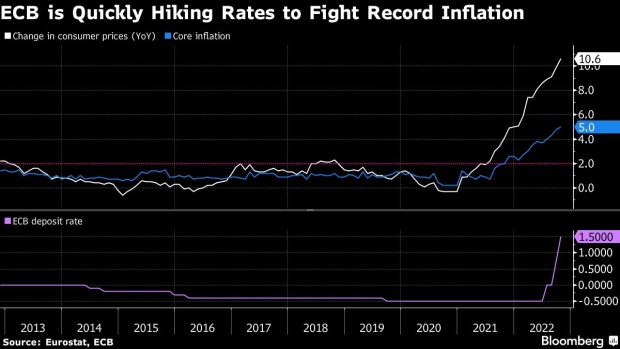Nov 25, 2022
ECB’s Best Way to Read Inflation Is Forecasting, Lane Says
, Bloomberg News

(Bloomberg) -- The European Central Bank’s best option to assess inflation trends is still comprehensive forecasting -- despite recent failures to capture the grueling cost-of-living crisis, according to Chief Economist Philip Lane.
In a blog post on Friday, Lane outlined various price gauges and developments the ECB considers to set monetary policy. He dismissed an over-reliance on monthly data that some officials argue is a better signal for where interest rates should go in the short term, and said wage growth will drive inflation for years to come.
While the latest inflation readings and underlying price measures are useful, “a proper assessment of the likely future path of inflation is best conducted in the context of a comprehensive macroeconomic projections exercise,” Lane said in the post of more than 17,000 words. The “conditional nature of inflation projections should always be fully appreciated,” he cautioned.
The ECB has raised rates by a total of 200 basis points since July and officials have signaled more hikes are in the pipeline to wrest control of inflation that tops 10%. Still, momentum for a third straight 75 basis-point step may be waning, with even some more hawkish policy makers embracing a more moderate, half-point move.
Monitoring pay will form a large part of understanding inflation trends as it’s likely to take several years for salaries to fully adjust to recent prices shocks, said Lane, who’s one of the ECB’s more dovish officials. “In this way, the wage-adjustment process may put upward pressure on price inflation over the next two or three years,” he said.
Long-term inflation expectations “currently appear well anchored” at the ECB’s 2% target, according to the Irish official, who defended the Governing Council’s meeting-by-meeting approach to setting monetary policy.
At the same time, he warned that governments’ efforts to alleviate the energy crisis are “scheduled” to boost inflation down the road -- a trend that could prove costly for the economy.
(Updates with comments on wages starting in second paragraph.)
©2022 Bloomberg L.P.





